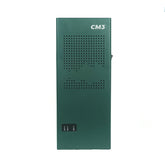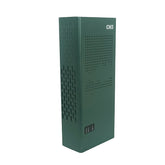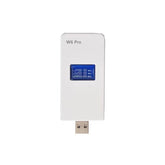How to Cure the Cell Phone Smuggling Epidemic in Prisons
It's no exaggeration to say that a cell phone is a lifeline to the world. Ever since it became affordable to carry a cell phone line and mini computer wherever we go, cell phones have gone from nice to necessary to not living without them. From the elderly to the smallest tyke, people love their phones – most people, anyway.
So who doesn't love cell phones? Anyone who works in a correctional facility - because in a prison, a cell phone isn't a fun, useful gadget: it's a security issue.
Contraband cellphones have long been a safety and public safety concern for correctional agencies around the world, and successfully detecting them before they cause harm is one of the biggest challenges facing staff. prison today.
A major problem for prisons
For the average correctional officer, a contraband weapon or drugs may be more dangerous inside the prison in the immediate term, but a cell phone is more harmful - because the damage it can cause far exceeds the prison walls.
Inmates can use a cell phone to pursue their drug trafficking or organized crime operations; threaten officials and intimidate witnesses and even coordinate killings. Some examples of the havoc a cell phone can wreak inside prison walls:
In the UK, inmates ran a cocaine ring, staged the murder of a teenager as part of a feud and arranged the murder of a gang leader. In 2018, federal prosecutors said two inmates used smuggled cellphones to run a violent, drug-dealing street gang inside California's Pelican Bay State Prison. South Carolina officials blamed a prison riot that killed seven inmates in April 2018 during a war between gangs over territory, cash and contraband items such as drugs and cellphones . Smuggled cellphones have been linked to coordinated attacks on prison officers and other illegal operations. A South Carolina Department of Corrections officer was shot six times after a hit was fired at a contraband phone. Fifteen prisoners housed in North and South Carolina correctional departments have been charged in a ring of "sextortion," in which they used contraband cellphones to target U.S. military personnel.
And it's not just a handful of phones that cause these issues; the numbers paint a grim picture of the extent of the problem. In South Carolina in 2017, prison guards found and took one phone for every three inmates, and many other agencies have similar phone-to-inmate ratios – for example, in Oklahoma it's one phone for every six inmates. At least 15,000 mobile phones or SIM cards were confiscated in English and Welsh prisons in 2017, equivalent to one in every six inmates. It is a generalized epidemic.
In order to combat the problem of mobile phone smuggling, some correctional facilities have explored "jamming" or blocking of mobile reception by using a device to transmit a signal on the same frequency and at a sufficiently high power as both the signals collide and cancel each other out.
Others are turning to so-called “managed access” in which only communications from approved devices are forwarded to cellular carriers, or international mobile subscriber identity capture (“capture”), in which phones are lured into a fake network and can be monitored or blocked.

But there are several reasons why these options won't stem the tide of illegal cellphones in prisons.
Signal manipulation is not efficient
While attacking contraband phones by their signals seems like a good way to ensure that even phones that enter prisons can't be used, there are some major flaws in this solution.
A mobile phone can be used as a data storage device as well as for transmission. Even without access to signal and data, a phone is still a useful data storage device. Inmates can record audio and video messages and arrange for the phone to enter and leave the prison through staff, visitors and other means, using the phone itself or its SD/SIM card to transport data and continue to carry out criminal activities. Phone/data storage cards may also be used internally only, to transmit information between inmates.
Staff can disable or unplug jammers, rendering them useless. It's not a scenario that prison officials like to imagine, but corrupt correctional officers and other staff can be bribed by inmates to temporarily unplug or disable jammers to allow inmates to spend calls or send data. When it is only a sporadic event, it is very difficult to detect it without catching the CO or the inmate red-handed.
Methods that target signals can create problems with internal communications. With mobile reception completely blocked, the signal blocker blocks all phones and SIM cards within range of the jammer, including those of prison staff. Seizure, along with managed access, allows staff phones to be put on unassigned "whitelists", but these methods are expensive.
Scrambling, Seizure, and Managed Access offer mixed results. Here's the biggest reason of all: these methods just aren't the all-encompassing solution officials once hoped for.
In 2012, California deployed managed access technologies in 18 of its 35 prisons, but halted program expansion in 2015 because other technologies outpaced the managed access system and shifted to others. kinds of solutions.
Managed access hasn't worked because cellular service providers have moved to technology commonly referred to as 4G or LTE (Long Term Evolution), which uses new frequency bands. Operators also transmit voice calls over what amounts to a Wi-Fi network. The Prisons Managed Access System does not capture Wi-Fi, Skype or satellite transmissions unless inmates use Skype and d other social media apps over a cellular connection. A nonpartisan study by the California Council on Science and Technology detailed a long list of additional potential problems with managed access even before the system was deployed.
The problem remains that the technology is always changing, which means that the jammer, keying and managed access systems are only as good as the technology for which they were designed. These systems would require constant upgrades to stay current – and not only are these methods expensive to deploy, they are even more expensive to upgrade.
Plus, where there's a will, there's a way - even with the latest technology. A trial in two Scottish prisons deployed a seizure system, which cost more than £1.2million to deploy. Report on trial shows 'resilience issues' and 'lack of intelligence' in system - and it all ended up costing nothing: Prisoners developed what authorities described as 'innovative countermeasures' to bypass the telephone block.
Prison officials know better than anyone that inmates will do anything to obtain contraband - invent a new method of detection or prevention, and inmates will find a way around the problem. Contraband has many portals of entry into a facility: unmanned aerial vehicles, or drones, can hover over fences; objects are thrown on the walls; food shipments and mail deliveries hide illicit materials; and inmates and staff on bail bring contraband in a side door – or even in their own bodies. Even the vendor of managed access systems for the California Department of Corrections told The Associated Press regarding the smuggled phones, “There's no silver bullet. You can't try to meet the demand, because the demand will always be there. "
The reality is that cell phone smuggling in prisons is a complex problem that no technology or method can solve. Instead, successfully fighting smuggled phones requires multiple technologies, tactics, and training.
The solution: the layered approach to security
To combat smuggling, correctional facilities must employ a layered security solution.
Tactics include highly skilled and trained personnel; traveling COs; walk-through metal detectors and x-ray equipment at major entry points; portable detection equipment; random screens; high fence / netting; drone detectors; shakedowns and more.
Technologies should be deployed at all entry points (front, rear, and side), as well as facility-wide. An example of something that can be used in a facility is a portable ferromagnetic detection system (FMDS), which uses passive sensors that detect a magnetic signature, down to one millionth of the earth's magnetic field. Installation and passive detection of ferrous metals as people and objects move takes less than a minute, allowing for increased detection in less time and fewer unnecessary close encounters between personnel and detained.
Staff can use the FMDS alongside X-ray equipment at entry points to screen people, then pick up the unit and use it throughout the facility to perform body searches of inmates and screen mail , laundry, mattresses and other inmate property. The units are battery operated - there is no need for an electricity source, as with a walkway detector, giving correctional officers the ability to provide an all-around security solution to a prison without worrying from a power source.
This technology has been deployed in 46 countries around the world, including all prisons in New Zealand and the United Kingdom; New York's 54 state prisons; Maryland's 24 state prisons; and in California and Indonesia. The FMDS goes beyond detecting phones and can detect any ferrous metal contraband, including weapons, and can even detect ferrous metal objects inside a human body - unlike wands or detectors passing.
The most important success factor for any correctional facility is its staff and the training they have received; all the innovative tactics and advanced technologies in the world don't matter if the staff don't know them well.
The human factor is vital in all aspects of security, and making personnel experts on tactics and technologies through hands-on training (including refresher courses for veteran COs) will help personnel understand how each method contributes to the layered security approach - and how it improves their own security too.
De nombreux outils, pas un seul
Les détenus ne cesseront jamais d'essayer de faire entrer clandestinement des téléphones portables et d'autres objets de contrebande, ce qui signifie que les prisons du monde entier ont du pain sur la planche - et aucune solution unique n'aidera à garder les téléphones à distance.
Une approche holistique à plusieurs niveaux de la sécurité qui englobe l'ensemble de l'établissement en utilisant à la fois la technologie et des méthodes traditionnelles, renforcée par une formation de haute qualité, est le moyen idéal pour empêcher la contrebande - y compris les téléphones portables - de perturber une prison.
Avoir de nombreux outils dans la boîte à outils est plus efficace que d'avoir un seul outil, et une solution de sécurité multicouche met de nombreux outils entre les mains des professionnels correctionnels, les aidant à maintenir l'ordre, la sécurité et la sûreté - à l'intérieur et à l'extérieur d'une prison.













